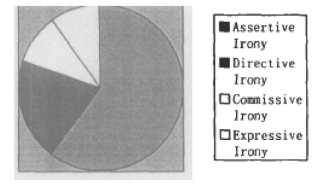3.3.2 Micro Ironic Speech Acts
Before micro ironic speech acts,first let's also take a look at micro speech acts.
Micro speech acts indicate the exchange amidst characters in a work.In Austen's works,most of the stories were developed mainly on the basis of various dialogues among characters.Austen was of great talent in dialogue depicting which forms the basic material and means in character painting.Her characters were so vivid as if we can hear their laughing and view their portraits.In skillfully narrating dialogues,Austen has many modes ofpresentation of character talk at her disposal,including not only direct speech and indirect speech,but also free direct speech and free indirect speech as well as letters—a special kind of dialogues in written form.
①Direct speech and indirect speech:The essential semantic difference between direct speech and indirect speech is that when one uses direct speech to report what someone has said one quotes the words used verbatim,with various traits retained,such as the reporting clause.Because the reporting clause can fully display implied meanings that the quoted utterances may fail to achieve,so usually direct speech can succeed to bring people's conversations before our eyes in a vivid manner,whereas in indirect speech one expresses what was said in one's own words.Indirect speech doesn't use quotation marks to enclose what the person said and it doesn't have to be word for word.If we take the following example of direct speech:
She said,“Next week's lesson is on reported speech.”Then we can easily convert it into indirect speech as follows:
She said the next week's lesson was on reported speech.
②Free direct speech:Free direct speech lacks a reporting clause to show the shift from narration to reporting;and it is often used in fiction to represent the mental reactions of characters to what they see or experience.Free direct speech can produce a freer form and fasten the conversational rhythm.In free direct speech,the characters apparently speak to us more immediately without the narrator as an intermediary.As we may know,too many reporting verbs will do a great damage to the balance of various pragmatic forces,even destroying subtle implications between the lines.Let's take a look at the following two examples of free direct speech:
Example 1:“I'llcome back here to see you again tomorrow.”
Example 2:“We never have any governess.”
Free direct speech speeds up the rhythm ofutterances,conforming to the development of personalities and events,giving full play to characters,and reducing the author's intervention to a minimum.Consequently,diverse characters were vividly portrayed and the narration was rendered more concise.
③Free indirect speech:Free indirect speech resembles indirect speech in shifting tenses and other references,but there is generally no reporting clause and it retains some features of direct speech(such as direct questions and vocatives).In this extract from Sense and Sensibility,Austen moves into free indirect speech when Elizabeth and Willoughby ran secretly away from the dancing party:
He joined most heartily in the general regret on so unfortunate an event;concluding however by observing,that as they were all got together,they must do something by way of being happy...They both seemed delighted with their drive,but said only in general terms that they had kept in the lanes,while the others went on the downs.
Since free indirect speech carries no guiding sentence,with quoted utterances being independent sentences,consequently,what people said can merge easily with literal narration,blending into one harmonious whole.In the meanwhile,free indirect speech complies with direct speech in some other language ingredients,thus retaining the quoted utterances in a vivid and lively manner.Compared with direct speech,free indirect speech utilizes similar person and tense,displaying narrator's intervention in characters'utterances,and increasing the distance between readers and what characters utter.Consequently,the readers can fully taste irony between the lines and obtain a deeper impression about people's actions.
④Letters:Letters are a special kind of dialogues in written form in literature works.In Austen's works,letters can be found everywhere for the characters to convey information or converse.Letters are critical in transforming the characters'feelings.After reading the letter,the readers can also get a profound understanding about the story and the characters.
Sense and Sensibility offered a picture of the middle-class gentry in the 18th century.Their daily life involved nothing but numerous visits,dinners,dances and walks.The majority of these social activities were spent in talking.Various dialogues engendered and the achieved friendship,love and marriage.In a sense,dialogues constitute the whole story.Without devious plots and thrilling great scenes,Austen,by her easy and smooth narration,attracted countless readers and critics generation after generation.A proof might be perceived in elegant dialogues in this book,which played a critical role in character painting.
Deliberately neglecting to present beautiful views and portraits in detail,Austen fulfilled her story and character depicting mainly through dialogues.Among dinners,dances beyond court,every dialogue was full of witty irony and dramatic plots.As we have mentioned,micro ironic speech acts indicate speech acts performed by characters in the story.What's more,Austen adopted many kinds of forms to display dialogues.So in Chapter Four,according to theories of Searle,I will explore in detail four kinds of micro ironic speech acts:assertive irony;directive irony;commissive irony and expressive irony.The rough proportion of these four kinds of speech acts may be illustrated in the following cake chart:

(Chart 1)
